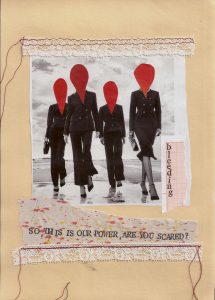
In the heterogeneous world of art, what other figure combines emotion, discovery, resourcefulness, trepidation, if not that of the curator? An eclectic, versatile, often complicated job, in which as well as the knowledge, it is passion that plays an essential role, that pushes you to get involved, and to make you live as many realities as possible. And in addition to constantly questioning, seeing the nuances through different angles, and finally creating, managing, celebrating. An “artistic” activity which we follow and pursue, and that is also carried out by the Turin-based Margaret Sgarra, who recently curated the exhibition entitled #penelope in Perugia.
It is a reflection and reinterpretation of the textile practice, conceived as an art medium and focused on the theme of the female condition in the contemporary world. Interviewing her allows us to better understand the dynamics of this profession, discussing the central aspects of this exhibition.
Undoubtedly the working as art curator is a profession full of possibilities, made up of research, study, inner universes, emotional and relational approaches, sacrifices and success. Can you tell us about your experience and what convinced you to choose this kind of work activity?
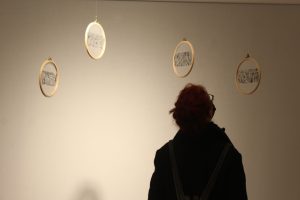
During my studies, which took place between Turin and Boulogne, I focused my attention on the artistic trends of the second half of the twentieth century. This pushed me to go further and also to get closer to today’s artistic scenario. University courses are essential to have a theoretical training, but it is necessary to face the actual difficulties that arise in shaping an exhibition project: comparing with the artists, relating to a space with specific characteristics, the set up, etc. These are all things that you have to learn managing, and the only way to do it is to get involved. In 2020 I attended N.I.C.E., a practical curating course organized by Paratissima Art Fair, and then I started to carry out some of my curatorial projects. I love contemporary art in its various forms and I am fascinated by reading works of art, analyzing their meanings, learning how they are made and the stories they want to tell. I think contemporary art is the mirror of our society and I want to give shape to the projects in which it’s analyzed. The construction of an exhibition is also a way that allows me to “read” current events, understand different views from mine, and this aspect enriches me a lot. The conception always starts from a question that I ask myself on a personal level and the construction of the exhibition allows me to receive multiple answers.
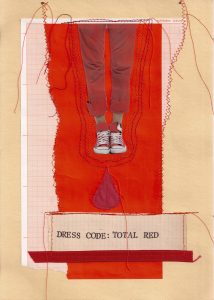
From a curatorial point of view, but also from a cultural and educational one, how do you consider the Italian artistic panorama? And, on the other hand, have you never related to the European or international context?
I think that being an artist today is not easy because you have to deal with everything that has already been done previously. In some cases it is thought that attending an art school is enough to be an artist, as if mastering the techniques is the only mean to be considered as such. Instead, it is necessary to have a critical ability to read our contemporaneity. And they don’t teach you that in courses. Often, attending exhibitions and artists’ studios, I happened to find myself in front of pieces with an aesthetic or technical potential that, however, could not go beyond that aspect. Anyone who wants to be an artist must have something to say, creating is not enough. Then, on a visual level, I am struck by the artistic researches that present hybrid languages, sometimes antithetical, and above all that are not afraid of disorienting or destabilizing those who observe them. Art must be courageous. As for the European and international context, I am very interested. I am also working to be able to compare myself to it, it is certainly in my projects.
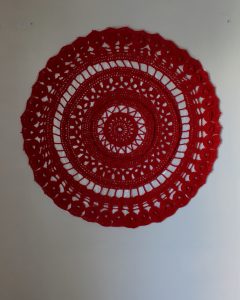
You recently curated the exhibition #penelope at the SCD Textile & Art Studio in Perugia. Can you explain how this idea was born, how did you choose the artists on display and what are the reflections / emotions you wanted to bring out?
The #penelope exhibition metaphorically weaves a thread between tradition and contemporaneity. The mythological figure of Penelope is combined with the hashtag, a symbol of the contemporary virtual dimension. Once textile practices were considered as a popular female tradition to create objects of common use. Today Fiber Art, in its various visual forms, is a type of art able to communicate, move and to make someone reflect. For this project I chose three female artists representing three modern “Penelopes”. They question themselves on some current issues: Alice Biondin on the female condition, Grazia Inserillo on the definition of identity and Francesca Rossello on the safeguarding of the environmental sphere. Alice Biondin focuses on menstruation (a theme that still represents a taboo) and on the body transformations due to pregnancy. Grazia Inserillo reflects on the role played by the place of birth in the construction of one’s self.
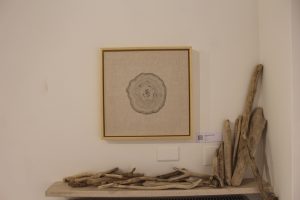
And Francesca Rossello establishes a parallelism between the internal human dimension and the inner one of nature. The general idea is to stimulate in the user reflections on the complexity of our present, through a type of art that once was considered only as a decorative practice. I would like contemporary art to be understood as a tool for reading what is happening and not as an “artistic object” for its own sake. I always find it very satisfying to interface with the public, to feel that after highlighting the hypothetical meanings of the work in question, the viewer is actually able to “view and” perceive “them, thus canceling the barrier that is created between the work of art and the individual.
Are there any characters related to the art environment or artists you are most inspired by?
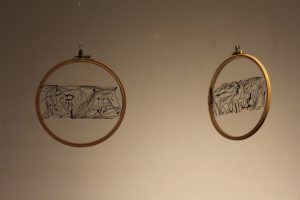
On a curatorial level, I greatly admire the figure of Germano Celant and his ability to have given shape to an artistic movement like that of Arte Povera, to which I am linked and I have addressed part of my studies to. Then there are several historicized artistic figures that I follow closely, among them: Sophie Calle, Michelangelo Pistoletto, Mario Merz, Gerhald Richter, Anselm Kiefer, Daniel Buren, Jeanne-Claude and Christo, Marina Abramović… just to name a few.
What are your upcoming curatorial projects?
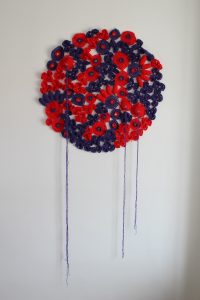
The next few months will be intense and I will be involved in different projects. At the end of March the collective exhibition Vis à vis Ritratti tra finzione e realtà will be inaugurated at the Ossimoro Art Gallery in Turin. Later I will move to Cereggio (RE), an ancient village in the Reggiano Apennines, to take care of an artist’s residence in collaboration with KAMart in residence and Bonioni Gallery in Reggio Emilia. The theme of this project will be roots as hidden bonds present in all individuals. Three artists will participate in the residency: Gabriella Gastaldi Ferragatta, Laura GuildA and Angela Viola. Also in Turin, I was selected as co-curator for the new Art Factory project in Paratissima. The Factory residences will take place from March to May and during this period will be organized studio visits and talks.
[foogallery id=”3917″]